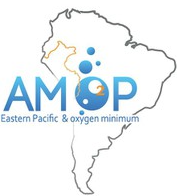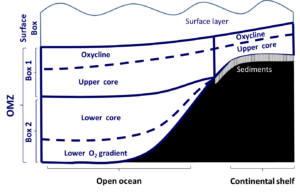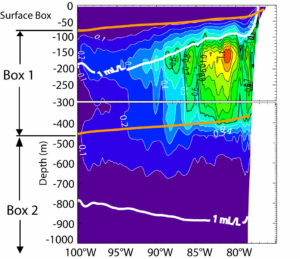Ocean deoxygenation is not only a “hot topic” currently in debate within the scientific community, it is also of the utmost importance for the future of marine ecosystems, arguably of comparable or greater significance to ocean acidification as a potential impact on marine biogeochemical cycles and ecosystems. Although there is a growing number of initiatives in the world that start to address this key topic, observational multidisciplinary approaches are still limited. The AMOP project focuses on a highly variable and intense biological oceanic area off Peru in the Eastern Pacific, which is well representative of the deoxygenated oceanic areas since it is one of the largest Oxygen Minimum Zones (OMZs), covering 87% of the total OMZs area.
AMOP is based on the Central Hypothesis that most of the coupling between physics and biogeochemistry takes place in an upper layer encompassing the oxycline and upper OMZ core, that is, advection and diffusion of O2 changes balance the production and consumption of O2 to form the rate of O2 changes. On the other hand, the lower core of the OMZ variability is mainly determined by the physical processes. To test the Central Hypothesis, the AMOP objectives propose a comprehensive mean O2 budget within the OMZ off Peru, considering the local and remote physical and biogeochemical O2 contributions and their spatio-temporal variability. In particular, this budget will take into account the ocean advection and diffusion processes as well as the consumption and production of O2 through bacteria, phytoplankton, zooplankton and particles degradation. AMOP will combine observations (cruise-mooring-satellite) and high-resolution model outputs to document the O2 tendency terms at a variety of timescales, from hourly to centennial. The combined use of in situ experiments and models outputs will allow deciphering the contributions of the physical processes versus the biogeochemical processes to the rate of O2 changes within the different OMZ layers.
From a technical point of view, the AMOP project will provide a unique benchmark, in real conditions at sea, for extremely precise measurements of O2 at the nanomolar concentration level (1000 times lower than usual methods) with several methods enabling to reduce as much as possible error bars in the budget.
OMZ conceptual model in AMOP: Box 1 encompasses the oxycline and the upper OMZ core;
Box 2 includes the lower OMZ core and O2 gradient.
Box 1 is assumed to be the region where physical processes (e.g. Advection associated with Peru-Chile UnderCurrent variability) have a comparable contribution to the rate of O2 changes than biogeochemical processes (e.g. O2 consumption associated with aerobic remineralization layer).
A separation between the open ocean and the continental shelf including the sediments component is considered in order to include the sediment O2 flux in the model.
Limits of boxes are defined based on the vertical scale of variability of the minimum O2 concentration (cf. on the right side).
RMS of intraseasonal to interannual anomalies (relative to the mean seasonal cycle) of minimum O2 concentration at 12°S in a regional coupled model simulation (Cf. Montes et al., 2014).
Note that a transformation was applied to O2 in order to emphasize regions of large variability of the low O2 concentration.
Since the model is forced by climatological boundary conditions, variability in minimum O2 concentration are due to biogeochemical processes and physical processes associated with the internal variability of the model (mesoscale activity).
The thick white lines correspond to the mean O2 concentration at 1 mL/L (44.61 µM).
Large values of variability are found just below the oxycline. The orange thick lines correspond to the limits of the two-box conceptual model (see on the left side) used as a theoretical framework for AMOP.
Their positions delimit the region where there is a balance between biogeochemical and physical processes (Box 1) and the one where physical processes (in particular at interannual timescales) are assumed to be dominant (Box 2).


